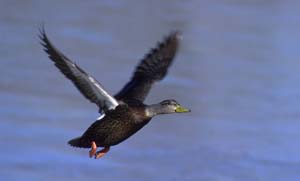<!–[if !mso]> st1:*{behavior:url(#ieooui) } <![endif]–>
st1:*{behavior:url(#ieooui) } <![endif]–>
 |
| Black duck |
The New York State Department of Envirnmental Conservation and the New York Cooperative Fish and Wildlife Research Unit (located at Cornell University) are conducting two black bear research projects in south-central New York this season. One study will estimate bear population density using a genetic (DNA) identification technique. The other will study bear movements and habitat selection in core bear ranges and fringe areas. Read more.
Also this spring, the NJ Department of Environmental Protection Division of Fish and Wildlife’s Endangered and Nongame Species Program is teaming up with Montclair State University and the Conserve Wildlife Foundation of New Jersey for the state’s first broad-based scientific study of chytrid fungus. The study seeks to find out if chytrid fungus is having an impact on the state’s amphibian populations. More info from the State of New Jersey.
This winter the Massachusetts Fish and Wildlife Department studied black ducks along the state’s coast. The department is concerned about the birds because their numbers have been declining. Read about the study in this article from the Cape Codder, via the WickedLocal Eastham blog. The study will continue for three more years.
The Indiana Department of Natural Resources, Division of Fish and Wildlife recently completed catfish research in the Wabash River. There had been no harvest limits on large catfish in the state, and the public had expressed concerns about fishing pressure. The state is looking into regulating the fishery. Some info on the regs from the Indiana General Assembly. A report on catfish in the Wabash River.
Photo: US Fish and Wildlife Dept.
